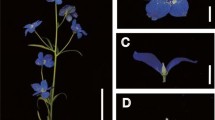Abstract
Pollination of flowers of standard carnation (Dianthus caryophyllus L. cv. White Sim) with pollen from flowers of miniature carnations (D. caryophyllus L. cv. Exquisite) caused them to wilt irreversibly within 1 to 2 days. Pollination stimulated a sequential increase in ethylene production by stigmas, ovaries, receptacles, and petals of the flowers. The ACC content of the stigmas increased rapidly in the first few hours after pollination. The possibility that subsequent production of ethylene by other parts of the flower is stimulated by translocated ACC is discussed. Ethylene production and ACC content of other parts of the flower reached their maximum 24 h after pollination. The petal tissues contributed the bulk of the ethylene productionper flower thereafter. There appears to be a qualitative difference between the enzyme in the stigmas converting ACC to ethylene and that in other parts of the flower.
Similar content being viewed by others
References
Adams DO, Yang SF (1979) Ethylene biosynthesis: Identification of 1-aminocyclopropane-1-carboxylic acid as an intermediate in the conversion of methionine to ethylene. Proc Natl Acad Sci USA 76:170–174
Arditti J (1971) The place of the orchid pollen “poison” and pollenhormon in the history of plant hormones. Amer J Bot 58:480–481
Arditti J, Hogan NM, Chadwick AV (1973) Post-pollination phenomena in orchid flowers. IV. Effects of ethylene. Amer J Bot 60:883–888
Bradford KJ, Yang SF (1980) Xylem transport of 1-aminocyclopropane-1-carboxylic acid, an ethylene precursor, in waterlogged tomato plants. Plant Physiol 65:322–326
Butler G, Reid MS, Yang SF (1980) Changes in 1-aminocyclopropane-1-carboxylic acid content of cut carnation flowers in relation to their senescence. Planta 150:439–442
Burg SP, Dijkman MJ (1967) Ethylene and auxin participation in pollen induced fading ofVanda orchid blossoms. Plant Physiol 42:1648–1650
Gilissen LJW (1977) Style-controlled wilting of the flower. Planta 133:275–280
Hall IV, Forsyth FR (1967) Production of ethylene by flowers following pollination and treatments with water and auxin. Can J Bot 45:1163–1166
Hoffman NE, Yang SF (1980) Changes of 1-aminocyclopropane-1-carboxylic acid content in ripening fruits in relation to their ethylene production rates. J Amer Soc Hort Sci 105:492–495
Hsiang Tsung-Hsun T (1951) Physiological and biochemical changes accompanying pollination in orchid flowers. 1. General observations and water relations. Plant Physiol 26:441–455
Konze JR, Kwiatkowski GMK (1981) Rapidly induced ethylene formation after wounding is controlled by the regulation of 1-aminocyclopropane-1-carboxylic acid synthesis. Planta 151:327–330
de Laat AMM, Brandenburg DCC, van Loon LC (1981) The modulation of the conversion of 1-aminocyclopropane-1-carboxylic acid to ethylene by light. Planta 153:193–200
Lipe JA, Morgan PW (1973) Location of ethylene production in cotton flowers and dehiscing fruits. Planta 115:93–96
Lizada CE, Yang SF (1979) A simple and sensitive assay for 1-aminocyclopropane-1-carboxylic acid. Anal Biochem 100:140–145
Lurssen K, Naumann K, Schroeder R (1979) 1-aminocyclopropane-1-carboxylic acid: An intermediate of the ethylene biosynthesis in higher plants. Z Pflanzenphysiol 92:285–294
Mor Y, Reid MS (1981) Isolated petals: A useful system for studying flower senescence. Acta Hortic 113:19–25
Nichols R (1977) Sites of ethylene production in the pollinated and unpollinated carnation (Dianthus caryophyllus) inflorescence. Planta 135:155–159
Riov J, Yang SF (1982) Effects of exogenous ethylene on ethylene production in citrus leaf tissue. Plant Physiol 70:136–141
Stanley RG, Linskens HF (1974) Pollen Biology Biochemistry Management. Springer-Verlag, Berlin pp 307
Wallner S, Kassalen R, Burgood J, Craig R (1979) Pollination, ethylene production and shattering in geraniums. HortScience 14:446
Yang SF, Pratt HK (1978) The physiology of ethylene in wounded plant tissues. In: Kahl G (ed) Biochemistry of wounded plant tissues. Walter de Gruyter, Berlin, pp 595–622
Yu Y, Yang SF (1980) Biosynthesis of wound ethylene. Plant Physiol 66:281–285
Author information
Authors and Affiliations
Rights and permissions
About this article
Cite this article
Nichols, R., Bufler, G., Mor, Y. et al. Changes in ethylene production and 1-aminocyclopropane-1-carboxylic acid content of pollinated carnation flowers. J Plant Growth Regul 2, 1–8 (1983). https://doi.org/10.1007/BF02042229
Received:
Accepted:
Issue Date:
DOI: https://doi.org/10.1007/BF02042229




